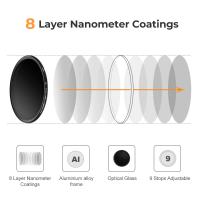Can You See Dust Mites With A Microscope?
Yes, dust mites can be seen with a microscope.
1、 Size and Appearance

Yes, you can see dust mites with a microscope. Dust mites are tiny arachnids that belong to the family Pyroglyphidae. They are not visible to the naked eye, as they typically measure around 0.2 to 0.3 millimeters in length. When viewed under a microscope, dust mites appear as translucent, oval-shaped creatures with eight legs. They have a characteristic appearance with a plump, rounded body and fine hairs covering their surface.
The latest point of view on this topic is that advancements in microscopy technology have made it easier to observe dust mites in greater detail. High-powered microscopes, such as electron microscopes, can provide even more detailed images of dust mites, allowing researchers to study their anatomy and behavior more effectively. This has led to a better understanding of dust mite biology and their role in allergies and asthma.
It's important to note that while dust mites are not visible to the naked eye, their presence can have a significant impact on human health. Dust mites thrive in warm, humid environments and feed on skin flakes shed by humans and animals. Their feces contain allergens that can trigger allergic reactions in some individuals, leading to symptoms such as sneezing, itching, and respiratory issues.
In conclusion, while dust mites are not visible without the aid of a microscope, advancements in microscopy technology have allowed for a more detailed understanding of these tiny creatures and their impact on human health.
2、 Habitat and Behavior

Dust mites are microscopic organisms that thrive in warm, humid environments, such as bedding, upholstered furniture, and carpeting. They feed on the dead skin cells shed by humans and animals, making them particularly common in areas where these cells accumulate. Dust mites are most prevalent in homes, where they can be found in high numbers in mattresses, pillows, and other soft furnishings.
These tiny creatures are not visible to the naked eye, as they typically measure around 0.2-0.3 millimeters in length. However, they can be seen with the help of a microscope, which allows for a closer examination of their physical characteristics and behavior. Using a microscope, researchers and scientists can study dust mites in detail, gaining insights into their biology, reproductive patterns, and interactions with their environment.
The latest point of view on dust mites and their visibility through a microscope remains consistent with previous findings. While advancements in microscopy technology continue to enhance our understanding of these organisms, the fundamental principles of their habitat and behavior remain unchanged. Researchers are continually exploring new methods to study dust mites and their impact on human health, particularly in relation to allergies and respiratory conditions.
In conclusion, dust mites are microscopic organisms that thrive in specific environmental conditions, and their behavior and habitat can be studied using a microscope. Ongoing research and technological advancements contribute to our understanding of these tiny creatures and their implications for human health.
3、 Microscopic Features

Yes, you can see dust mites with a microscope. Dust mites are tiny arachnids that are invisible to the naked eye, measuring only about 0.2 to 0.3 millimeters in length. When viewed under a microscope, their microscopic features become apparent, including their eight legs, segmented bodies, and mouthparts adapted for feeding on skin cells and other organic matter.
Using a microscope, researchers and scientists have been able to study the anatomy and behavior of dust mites in detail. This has led to a better understanding of their biology, life cycle, and the allergens they produce, which has important implications for managing allergies and asthma triggered by dust mite exposure.
Recent advancements in microscopy techniques, such as high-resolution and electron microscopy, have allowed for even more detailed examination of dust mites and their microscopic features. These advanced techniques have provided insights into the ultrastructure of dust mites, including their exoskeleton, sensory organs, and reproductive organs, contributing to a deeper understanding of their biology and potential control strategies.
In conclusion, while dust mites are not visible to the naked eye, they can be observed and studied using a microscope, and recent advancements in microscopy have further enhanced our understanding of these microscopic creatures.
4、 Health Implications

"Can you see dust mites with a microscope?"
Yes, dust mites are microscopic organisms that are not visible to the naked eye. They typically measure about 0.2-0.3 millimeters in length, making them too small to be seen without the aid of a microscope. Dust mites are a common allergen and can be found in household dust, bedding, and upholstered furniture. While they are not harmful to most people, individuals with allergies or asthma may experience health issues when exposed to dust mites.
Health Implications:
Exposure to dust mites can trigger allergic reactions in some individuals, leading to symptoms such as sneezing, runny or stuffy nose, itchy or watery eyes, and in severe cases, asthma attacks. Prolonged exposure to dust mites can exacerbate these symptoms and contribute to chronic respiratory issues.
The latest point of view:
Recent research has highlighted the potential link between dust mite exposure and the development of childhood asthma. Studies suggest that early exposure to dust mites may increase the risk of developing asthma in children who are genetically predisposed to the condition. This has led to a greater emphasis on reducing dust mite exposure in early childhood as a preventive measure for asthma.
In conclusion, while dust mites themselves may not be visible to the naked eye, their presence can have significant health implications for individuals with allergies and asthma. Efforts to minimize dust mite exposure through regular cleaning, using allergen-proof bedding, and maintaining low humidity levels in the home can help mitigate the associated health risks.





































